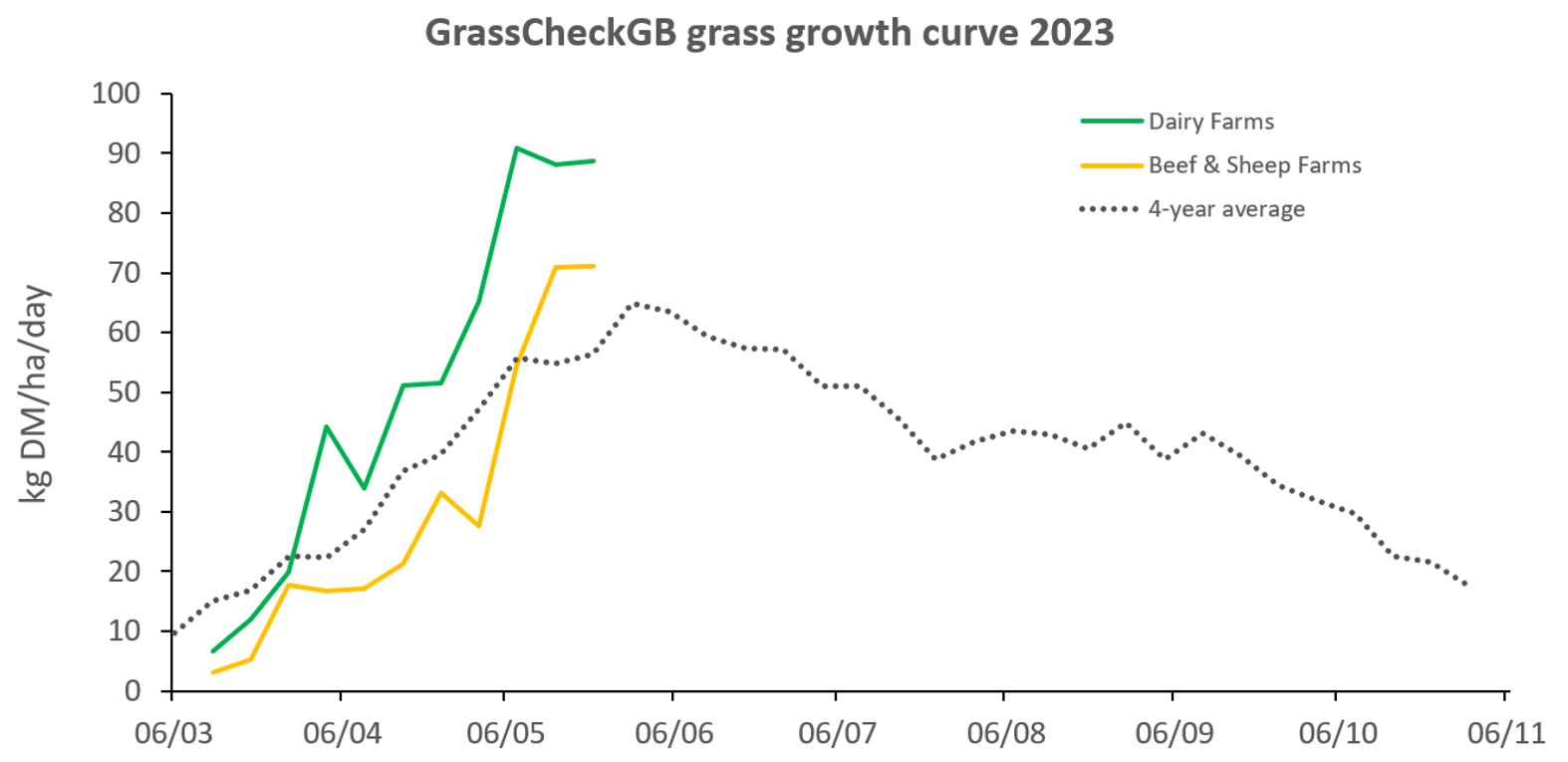Maintaining Grass Quality When Growth Rates Are High
30 May 2023It can be very tricky to manage grass quality and allocations when growth rates are high and exceed demand. Even with good rotational management practices, once the cows have been round the grazing platform a couple of times it can be harder to get cows to graze down to the target residual and the amount of grass rejection can increase, reducing grass utilisation and quality. This article will advise you on the best way to manage your fields and ensure good quality grass for grazing.

Dealing with above-average grass growth
Current data from the week beginning 22nd May shows that grass growth rates have really taken off, with the average growth rates on dairy farms in Scotland being 102.2kg DM/ha/day. The grass growth curve across GB so far this year is shown below, with growth for both dairy, and beef and sheep farms being well above the 4-year average. In terms of nutritional quality, across all GB farm types, dry matter was 17.9%, ME 11.4 MJ/kg DM and crude protein 17.4% DM.

GrassCheckGB provide data on grass growth rates and grass quality from 50 dairy, beef and sheep farmers from across Scotland, England and Wales, with weekly data available here:
In the scenario above there are a number of things that can be done to ensure grass quality is maintained for the next round. These include: pre-mowing, post-mowing or grazing with youngstock or dry cows. The benefit of mowing is achieving the target 1500kg DM/ha residual. The risk is if you put other stock on to tidy up the fields, either the target residual is not achieved, or the stock may suffer in terms of reduced growth rates, especially in younger animals. If low yielding cows are used to tidy up residuals, milk yield may be reduced.
However, the benefit of getting the residual down to the target is maintaining grass quality for longer, with better regrowth and leafy swards in the next round as more of the stemmy, older plant material has been removed.
Measuring your cover will help you plan your rotation
Measuring grass covers with a plate meter to assess available kg DM/ha once a week is a great way to assess how your paddocks are performing and whether you need to alter the pattern of the next paddocks to be grazed. It is likely that during times of peak grass growth, there needs to be some flexibility in what paddocks are to be grazed next. If you are working to a 21-day rotation, think about which fields you plan to graze in 3 weeks’ time and keep an eye on their regrowth and adjust the plan if required, based on grass growth in each paddock. Plate metering will also help identify poorer performing paddocks which would benefit from reseeding.
The cows will also help tell you about the quality of the grass. If it has got too far in front of them, energy intake will be lower as the grass is more fibrous and less digestible. This in turn can reduce milk output, as well as the protein percentage, which is driven by energy intake. Perhaps not what you’d expect if there appears to be an abundance of grass in front of the cows!
Methods for maintaining grass quality
Maintaining grass quality and dealing with a surplus of grass can be done by:
- Increasing the stocking rate – bring in youngstock or dry cows to the milking platform.
- Reduce the area available for grazing by taking out paddocks to bale for silage. If it looks like grass will be in surplus for a prolonged period, use this as an opportunity to reseed poorer performing areas.
- Reduce buffer feeding – both forage and concentrate will substitute grazed grass, with conserved forage having a greater substitution rate.
- Apply less N fertiliser post-grazing.
There are software packages that allow you to input weekly grass covers from all your paddocks and livestock details to create a grass budget for the farm and monitor when there are surpluses and deficits to requirements. This will be illustrated in the grass wedge, which shows the livestock demand and available covers in each paddock, with an indication of whether they are in surplus or deficit. It is a good visual guide as to which paddocks should be grazed next and which paddocks should be taken out of the rotation.
lorna.macpherson@sac.co.uk; 07760 990901
Sign up to the FAS newsletter
Receive updates on news, events and publications from Scotland’s Farm Advisory Service
